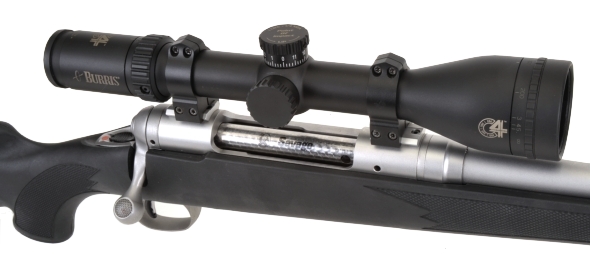
Rifles have their attributes and features but, in the land of synthetic stocks and stainless steel barreled actions, there is no fancy wood grain or fineness of bluing to give a rifle a unique personality. Subsequently, personality often resides within the combination of rifle and cartridge. In this case, the Savage Model 116 Weather Warrior and 6.5-284 Norma takes on the personality of an exceptional hunting rifle that is suitable for any medium to large thin skinned game. The cartridge’s velocity is not so great as to exceed a bullet designers’ intended impact velocity at close ranges, yet great enough to drop game at very long shooting distances; New England deer to Alaskan Dall Sheep.
The Savage Model 116 FCSS has a 24″ sporter weight barrel which, combined with the AccuStock, makes this Weather Warrior the natural all purpose 6.5-284 Norma hunting rifle within the Savage 6.5-284 Norma lineup. For folks preferring something greater in barrel length, the 1.5 pound heavier Long Range Hunter has a 26″ barrel, the Target Bench Rest has a 29″ barrel and the Target F Class has a 30″ barrel. The latter two rifles hovering around the 13 pound mark. For the light weight and fast handling priorities of hunting, the 24″ barrel Model 116 6.5-284 Norma suits the application well.
Despite the Model 116’s lightweight, in 6.5-284 Norma it generates only moderate recoil, ammunition costs, factory or handloads, is reasonable and the Savage is an easy rifle to shoot well. The stock pull length is a good compromise, the grip radius is comfortable, the checkering inserts are appropriately placed and stock girth, balance and weight feel… natural.
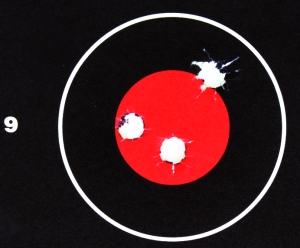 Throughout range sessions and field shooting, the Savage cycled easily and fed and ejected reliably. The 6.5-284 Norma Model 116 is built on a long action with a capacity, bolt stroke and magazine feed that exceeds 3.5″. Other than assuring adequate bullet/rifling clearance, a handloader has wide latitude to optimize ammo and to avoid deep seating long bullets.
Throughout range sessions and field shooting, the Savage cycled easily and fed and ejected reliably. The 6.5-284 Norma Model 116 is built on a long action with a capacity, bolt stroke and magazine feed that exceeds 3.5″. Other than assuring adequate bullet/rifling clearance, a handloader has wide latitude to optimize ammo and to avoid deep seating long bullets.
This 3 shot, 100 yard group measures 0.75″ on the target. Shot from a rest, 125 grain Nosler Partition bullets, it represents the worst group shot from the Model 116 from a first lot of only preliminarily sorted out handloads. The balance of shooting performance is included in the handload tables below.
Yes, you are absolutely correct, a product summation usually shows up at the end. However, I have an explanation that does not contain the words “dog”, “ate” or “homework”. The 6.5-284 Norma is an interesting round that led me down the path of tedious, technical minutia. By getting the salient points of the rifle review into the opening comments, there is less chance of the reader missing that important information, in the event they read through the mind numbing cartridge and handloading trivia that follows and lapse into a coma.
Stop me if you’ve read this before. No. Stop me. You’ve read this before.
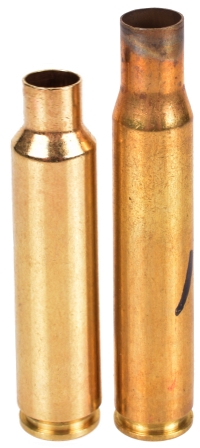 Pictured far left, the net result of the .284 Winchester’s development was the gift of a short cartridge with a nominal capacity of 66 grains, only 2 grains less than the 30-06. Model 100 and Model 88 Winchester rifles chambered for the .284 Winchester fell out of production in the early 1970s, but the cartridge lived on in many forms. A quick scan of “Wildcat Cartridges”, “Designing and Forming Custom Cartridges”, and “The Handloader’s Manual of Cartridge Conversions” turned up no less than 17 wildcat cartridges based on the .284 Winchester case. Unfortunately, few made a commercial conversion.
Pictured far left, the net result of the .284 Winchester’s development was the gift of a short cartridge with a nominal capacity of 66 grains, only 2 grains less than the 30-06. Model 100 and Model 88 Winchester rifles chambered for the .284 Winchester fell out of production in the early 1970s, but the cartridge lived on in many forms. A quick scan of “Wildcat Cartridges”, “Designing and Forming Custom Cartridges”, and “The Handloader’s Manual of Cartridge Conversions” turned up no less than 17 wildcat cartridges based on the .284 Winchester case. Unfortunately, few made a commercial conversion.
The oldest wildcat version of the .284 Winchester to 6.5 caliber is simply identified as the 6.5-284 Winchester. One of the more unique .284 Winchester wildcats is the 6.5 Express Junior, the work of Ralph M. Payne, Payne’s Custom Gunsmithing, Ventura, CA. Payne necked the .284 Winchester down to 6.5 and fire formed Weatherby type double radius shoulders, which yielded …about the same performance as the original angular shouldered wildcat, but with so much more panache. 1) Yes, that was the first time I ever found a use for the word “panache”. In the end, the 6.5-284 Norma cartridge came to represent the standard.
What makes this an effective cartridge? Better flame front? Pressure flow? More rigid action? I don’t know. My working theory is that short stout rounds are created by short, stout guys who wish to create in their own image. However, considering the number of 1,000 yard events won with this cartridge and the number of big game animals dropped at a distance, there may be something of greater substance at work.
The bullet weight to length ratio of a 6.5mm bullet, 0.264″, typically produces a high sectional density and a high ballistic coefficient. The result is a bullet of a given weight hanging onto velocity longer than many other calibers of similar bullet weight. Even more modest 6.5mm cartridges like the modest 260 Remington can launch a bullet at a moderate speed and remain supersonic beyond 1,000 yards. The 6.5-284 Norma cartridge has all of these same positive attributes, but to an even greater extent. Savage is one of the few companies to see the assembly line potential of the 6.5-284 Norma and package it for both competitive shooters as well as for long distance hunting.
How large is the demand for the 6.5-284 Norma? The original 284 Winchester warrants only a seasonal run by Winchester and brass is not often to be found. The 6.5-284 Norma derivative is routinely produced by Hornady, Lapua, Norma, Nosler and is continually in stock even during these periods of tight supply. Additionally, there is factory ammo and a wide variety of tools for the handloader to make the most out of this combination. It is a popular cartridge.
Some observations while prepping for handloads…
Barnes, Lee and Speer reloading manuals ignore the 6.5-284 of all types, including the Norma commercial standard and provide no reference data. Hornady lists the 6.5-284 Winchester as having a 2.800″ maximum COL, a short action cartridge. Sierra lists the cartridge as the 6.5-284 Winchester, but then refers to it as the 6.5-284 Norma in the spec box, then refers to it as the 6.5/284 wildcat in the supporting text for the cartridge. The drawing illustrating the listing notes “optional” in place of an actual COL dimension, however, their maximum COL listing for a long 140 grain bullet is 2.910″. I suspect the wandering reflects the evolution of the entry. Nosler lists the 6.5-284 Norma, defines a maximum COL as 3.310″ which agrees with no reference data, including CIP 2), and Nosler does not post recommended assembled length for each bullets. No, I don’t know why, as COL is critical data and has a direct impact on pressure. In any event, the CIP maximum COL standard for the 6.5-284 Norma is 82mm or 3.228″.
Gees, Louise… how the heck do I load this thing? Baseline with Sierra, Hornady and Nosler manual data, respect the start load suggestions and COL recommendations where expressed and document assembly and results. Then fiddle with COL, adjust charges progressively and accordingly until you are in the range of published velocity for the barrel length of your rifle. When you’ve discovered 100+ fps more velocity for a corresponding set of components and powder charge, stop because your ammo is running at excessive pressure levels. There is no trick that will allow a handloader to beat published data by that great of a margin. Do not rely on predictive software as a sole method of determining powder charges. It was never intended for that purpose.
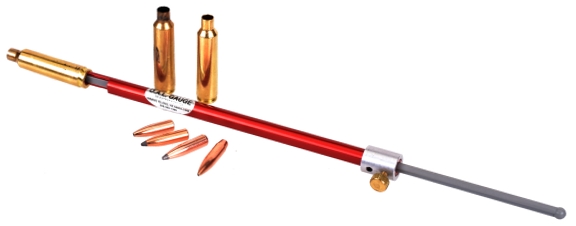
QuickLoad pressure predictive software lists Pmax pressure as 59,456 PSI, CIP list Pmax as 4,400 BAR, or 63,802 PSI equivalent, or about the same as the parent .284 Winchester’s Pmax of 63,817. Oddly enough, based on correlation of component manufacturers’ handload data and resulting velocity and pressure data, QuickLoad understates 6.5-284 Norma pressure by as much as 20%. One of the reasons pressure predictive software should never take the place of test instrument acquired reference data, or be used as more than one tool for handload development.
Justification for owning a dial caliber?
After running checks on each bullet type for bullet ogive to leade clearance, I realized I was spending a great deal of time and not getting anywhere fast. When it came to a choice of a uniform COL across all bullet types, versus a critical measurement for each for an upside of 18 fps and no perceptible change in accuracy, I wiped the table entries for Maximum Cartridge COL and set them all to 2.800″ and developed loads on that basis.
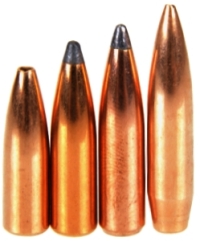
| Bullet Type | Weight Grains |
Length Inches |
Maximum Cartridge COL “ |
| Sierra Varminter | 100 | 0.928 | 2.800 |
| Sierra Pro-Hunter | 120 | 1.085 | 2.800 |
| Nosler Partition | 125 | 1.175 | 2.800 |
| Nosler Custom | 140 | 1.306 | 2.800 |
Because of its long action, the Savage Model 116 offers greater latitude for a greater maximum COL dimensions than component manufacturers manuals suggest. However, after much measuring, shuffling of seating depth and test load firing, selecting a uniform length yielded best accuracy and moderate start pressure. I am sure more can be wrung out of the combination, but that wasn’t the intent of this handloading exercise. I did encounter one anomaly when using Sierra data and bullets.
The Sierra manual recommended short 2.710″ length with its short, 100 grain, relatively blunt tipped Varminter hollow point. The Savage’s long magazine placed the cartridge far back in the magazine and caused the bullet tip to snag on the edge to the feed ramp late in the bolt stroke, top photo. Increasing the COL with that bullet by 0.070″ apparently altered the magazine release timing by getting the bullet nose into the feed ramp earlier in the bolt stroke, bottom photo, and the problem went away.
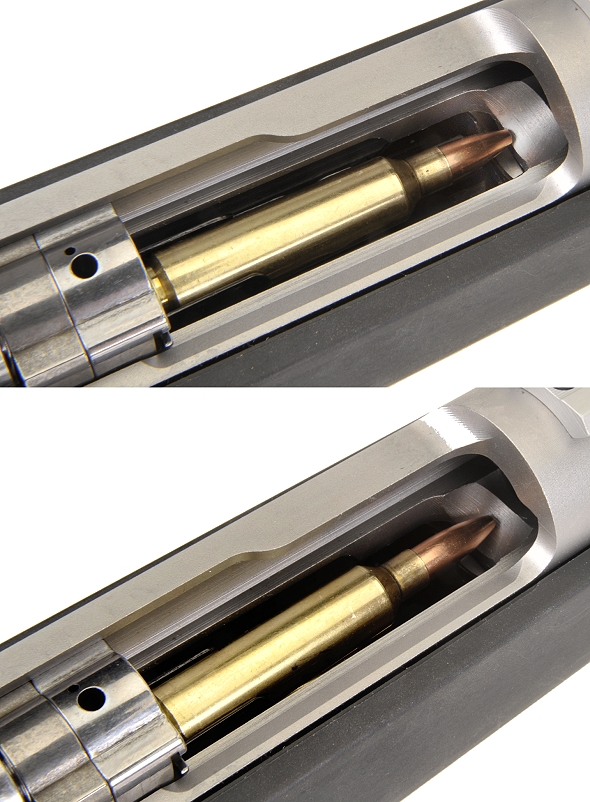
Handloads wrapped up
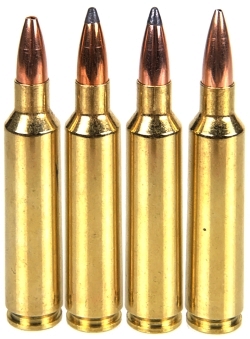
 |
Warning: Bullet selections are specific, and loads are not valid with substitutions of different bullets of the same weight. Variations in bullet length will alter net case capacity, pressure and velocity. Primer selection is specific and primer types are not interchangeable. These are maximum loads in my firearms and may easily be excessive in others. All loads should be reduced by 5%, and developed following safe handloading practices as represented in established reloading manuals produced by component manufacturers. Presentation of these loads does not constitute a solicitation for their use, nor a recommendation.
|
||||||||||||||||||||||||||||||||||||||||||||||||||||||||||||||||||||||||||||||||||||||||||||||||||||||||||||||||||||||||||||||||||||||||||||||||||||||
|
|||||||||||||||||||||||||||||||||||||||||||||||||||||||||||||||||||||||||||||||||||||||||||||||||||||||||||||||||||||||||||||||||||||||||||||||||||||||
Brass held up well. No splits, tattooed case heads or signs of other damage. The Savage chamber was pretty tight as fired brass wet capacity increased from 65.8 when new to just 66.4 grains of H2O after firing. All of the shooting was done from a sled in an effort to separate rifle performance from my own. If it weren’t for a tad of muzzle blast, it would be easy to forget this is a significantly overbore cartridge that dumps approx 18,000 PSI of pressure at the muzzle.
Savage Model 116 FCSS wrapped up
During the course of this project, I had the opportunity to disassembled the rifle, take a good look at the detail of its construction and the fit and finish of all of its parts. It is a product of quality manufacture and quality materials. I also had the opportunity to carry the rifle in the surrounding woods and get in some live fire in varying situations, elevations and inclinations. With a near 300 yard point blank range, there isn’t much in the Maine woods that required more than being in the cross hairs of the scope without range compensating or guestimating. Nice rifle… good looking rifle. ,,, good shooting rifle.
1) Handbook for Shooters and Reloaders Volume II – P.O. Ackley
2) Commission Internationale Permanente pour l’Epreuve des Armes à Feu Portatives
Savage’s Model 116 FCSS 6.5-284 Norma Part I
Savage’s Model 116 FCSS 6.5-284 Norma Part 2

Email Notification